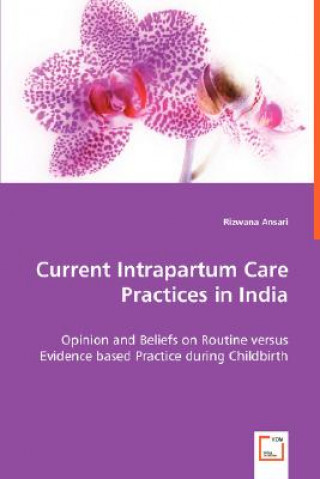
Kód: 08909018
Current Intrapartum Care Practices in India
Autor Rizwana Ansari
According to the annual report of the Government of India, 100,000 women annually continue to die because of childbirth related complications (Ministry of Health and Family Welfare (Government of India), 2000-2001). In India, over ... celý popis
- Jazyk:
 Angličtina
Angličtina - Vazba: Brožovaná
- Počet stran: 80
Nakladatelství: VDM Verlag Dr. Mueller E.K., 2008
- Více informací o knize

Mohlo by se vám také líbit
Dárkový poukaz: Radost zaručena
- Darujte poukaz v libovolné hodnotě a my se postaráme o zbytek.
- Poukaz se vztahuje na celou naši nabídku.
- Elektronický poukaz vytisknete z e-mailu a můžete ihned darovat.
- Platnost poukazu je 12 měsíců od data vystavení.
Více informací o knize Current Intrapartum Care Practices in India
Nákupem získáte 154 bodů
 Anotace knihy
Anotace knihy
According to the annual report of the Government of India, 100,000 women annually continue to die because of childbirth related complications (Ministry of Health and Family Welfare (Government of India), 2000-2001). In India, over 90% of women become mothers and a majority of them deliver without skilled assistance during delivery. This translates to approximately 30 million women in India experiencing pregnancy every year, and 27 million having live births (Bakshi, 2006). Of these, 136,000 maternal deaths occur every year due to childbirth complications, most of which can be prevented. Literature reveals that lack of appropriate care during pregnancy and childbirth, and especially the inadequacy of services for detecting and managing complications, explains most of the maternal deaths. Less attention has been paid to the quality of care within hospital based-services and there is growing evidence that women receive and experience appalling care in some institutions. A convenience sample (n = 188) of maternity care providers comprising doctors and nurse-midwives was obtained from the northern states of India. A semi-structured survey questionnaire was developed with 34 items in the form of fixed-choice and open ended questions. The developed questionnaire was intended to measure the intrapartum care practices comprising six elements: episiotomy, labor induction, birthing position, labor pain management, fundal pressure, and childbirth support. Statistical Package for the Social Sciences (SPSS) software was used for descriptive analysis of the data. The findings of the study demonstrated that providing lithotomy position at the time of delivery and giving episiotomy to all primigravida mothers were highly practiced during intrapartum care. Care providers believe that episiotomy has more benefits over perineal laceration, such as easy wound healing, prevention of deep perineal lacerations, easy to deliver the baby, mother experiences less pain, and there are less chances of hematoma formation. Significant differences were found for the practice of fundal pressure between doctors and nurse-midwives (p = < .05). Maternity care providers from government and non-government hospitals had significant differences in their opinion towards conducting episiotomy for all deliveries (mean = .000) and to all primigravidas (.002). The study findings suggested that self-reported practices of maternity care providers reflect a big gap in the utilization of evidence based-practices. Hence, more descriptive and interventional studies need to be done in India to identify the barriers that may impact implementation of evidence-based practices.
 Parametry knihy
Parametry knihy
Zařazení knihy Knihy v angličtině Medicine Nursing & ancillary services Midwifery
1540 Kč
- Plný název: Current Intrapartum Care Practices in India
- Autor: Rizwana Ansari
- Jazyk:
 Angličtina
Angličtina - Vazba: Brožovaná
- Počet stran: 80
- EAN: 9783639014518
- ISBN: 9783639014518
- ID: 08909018
- Nakladatelství: VDM Verlag Dr. Mueller E.K.
- Hmotnost: 118 g
- Rozměry: 229 × 152 × 4 mm
- Datum vydání: 20. May 2008
Oblíbené z jiného soudku
-

Hypnobirthing
419 Kč -

Gentle Birth Method
463 Kč -

Labor Progress Handbook - Early Interventions to Prevent and Treat Dystocia, 4th Edition
1708 Kč -

Myles Textbook for Midwives
1635 Kč -

Birth and Breastfeeding
302 Kč -

Bobath Concept - Theory and Clinical Practice in Neurological Rehabilitation
2850 Kč -

Water, Birth and Sexuality
302 Kč -

Student's Guide to Becoming a Midwife 2e
1156 Kč -

Myles Midwifery Anatomy & Physiology Workbook
847 Kč -

The Placenta
4111 Kč -

Advancing Skills in Midwifery Practice
1291 Kč -

Evidence and Skills for Normal Labour and Birth
6328 Kč -

Telephone Triage Protocols for Nurses
3027 Kč -

Anatomy and Physiology for Midwives
1281 Kč -

Fundamentals of Midwifery - A Textbook for Students
1190 Kč -

Fetal Monitoring in Practice
1344 Kč -

Fetal Medicine
5255 Kč -

Midwifery Testbook
1075 Kč -

Twin and Higher-order Pregnancies
3527 Kč -

Midwifery
740 Kč -

Comprehensive Clinical Approach to Diabetes During Pregnancy
3723 Kč -

Midwifery Essentials: Infant feeding
551 Kč -

Psychology for Nurses and Health Professionals
5563 Kč -

Stigma and Social Exclusion in Healthcare
5754 Kč -

Introduction to Research for Midwives
1353 Kč -

Evidence Based Midwifery - Applications in Context
1538 Kč -

Happy Birth Book
463 Kč -

Perspectives on Midwifery and Parenthood
2357 Kč -

Midwifery and Sexuality
1481 Kč -

Midwifery Essentials: Basics
406 Kč -

Active Management of Labour
1783 Kč -

Book For Midwives - New Edition
538 Kč -

Bread, Jam and a Borrowed Pram
312 Kč -

Midwifery Practice: Critical Illness, Complications and Emergencies Case Book
1193 Kč -

Evidence and Skills for Normal Labour and Birth
1544 Kč -

Twelve Babies on a Bike
312 Kč -

Theory for Midwifery Practice
1534 Kč -

Midwifery Casebook: A Practical Record of Maternal and Newborn Nursing - For BSC Nursing Students
549 Kč -

Choice, Control and Contemporary Childbirth
1429 Kč -

Midwife's Handbook
1207 Kč -

Adverse Outcomes in Maternity Care
1319 Kč -

Perinatal Loss
1390 Kč -

Fundamental Themes in Clinical Supervision
1724 Kč -

Her Story
446 Kč -

Labour Midwifery Skills
381 Kč -

Dying to Care
1725 Kč -

Helpers In Childbirth: Midwifery Today
5563 Kč -

Complementary Therapies in Maternity Care
1032 Kč -

Supportive Care and Midwifery
2617 Kč
Osobní odběr Praha, Brno a 12903 dalších
Copyright ©2008-24 nejlevnejsi-knihy.cz Všechna práva vyhrazenaSoukromíCookies




 Vrácení do měsíce
Vrácení do měsíce 571 999 099 (8-15.30h)
571 999 099 (8-15.30h)